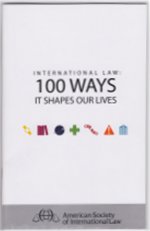
DRIVING CARS WITH IMPROVED SAFETY STANDARDS
By: James G. Apple, Editor-in-Chief, International
Judicial Monitor, and President, International Judicial Academy.
(In celebration
of the 100th anniversary of the founding of the American
Society of International Law in 2006, the Society published a small pamphlet
titled International Law: One Hundred Ways
It Shapes Our Lives. The Introduction
gives an explanation for its conception: an affirmation that “international law
not only exists, but also penetrates much more deeply and broadly into everyday
life than the people it affects may generally appreciate.” This column seeks to
elucidate and elaborate on many of the 100 ways briefly presented in the ASIL
pamphlet.)
Automobiles have been
around in one form or another for over 200 years, beginning in 1807 when the
first internal combustion engine was built. The first true automobile was
invented by Karl Benz in Germany in 1878 and patented in 1879. By the end of
the century his company produced, in 1899, 572 automobiles.
About the same time as
Benz was designing and building his motor car, an American inventor, George
Seldon of Rochester, New York designed but never built an internal combustion
engine. However the Duryea brothers of Springfield, Massachusetts, in 1893
designed and built a gasoline powered automobile that they demonstrated on the
streets of Springfield on September 21 of the same year.
Michigan became the
center of the American automobile business as a result of the efforts of Ransom
E. Olds developing in 1902 what became the Oldsmobile, built in Lansing along
an assembly line; and also of Henry Ford, who expanded and perfected the
assembly line method of production for his Ford motor cars at his Dearborn,
Michigan plant beginning in 1914.
Since the early days of
the 20th century, the types of cars, models of cars, and numbers of
individual units, have expanded astronomically as many different entrepreneurs
over the years have tried their hand at automobile manufacturing, distribution
and sales. Perhaps the archetype of the automobile entrepreneur is Preston Tucker, the inventor and
manufacturer of the Tucker Torpedo in 1948, whose career was featured in a full
length film, Tucker: The Man and His Dream (1988).
It has been estimated
that there are between 5000 and 10,000 types of cars in the world. That is not
a very helpful estimate, since there is so much difference between the two
numbers. A better estimate suggested that there are at least 1000
different makes of automobiles on the roads of the world today. Another speculation listed 84
current makes of automobiles. Here is the list and origins of each of them:
Acura (JAP - luxury)
Alfa Romeo (ITA - mid-grade)
Alpine (FRA - defunct high-end)
Aston Martin (UK - high-end)
Audi (GER - budget/mid-grade/luxury)
Bentley (UK - high-end)
BMW (GER - mid-grade/luxury)
Bristol (UK - high-end)
Bugatti (FRA - high-end)
Buick (USA - mid-grade)
Cadillac (USA - luxury)
Chevrolet (USA - mid-grade)
Chrysler (USA - mid-grade)
Citroen (FRA - mid-grade)
Cizeta (ITA - defunct high-end
[see Lamborghini])
Dacia (ROM - budget)
Daihatsu (JAP - budget)
Daewoo (KOR - budget)
DMC (USA - defunct high-end)
Dodge (USA - mid-grade)
Eagle (USA - budget)
Ferrari (ITA - high-end)
Fiat (ITA - budget)
Ford (USA - mid-grade)
FPV (AUS - mid-grade)
Gillet (BEL - high-end)
Ginetta (UK - high-end)
Holden (AUS - mid-grade)
Hommel (FRA - high-end)
Honda (JAP - budget)
Hyundai (KOR - budget)
Infiniti (JAP - luxury)
Isuzu (JAP - budget)
Jaguar (UK - high-end)
Jeep (USA - mid-grade)
Kia (KOR - budget)
Lada (RUS - budget)
Lamborghini (ITA - high-end)
Lancia (ITA - budget)
Land Rover (UK - high-end)
Lexus (JAP - luxury)
Lincoln (USA - luxury)
Lister (UK - defunct high-end)
Lotus (UK - high-end)
Marcos (UK - high-end)
Maserati (ITA - high-end)
Maybach (GER - high-end)
Mazda (JAP - mid-grade)
McLaren (UK - high-end)
Mercedes-Benz (GER - mid-grade/luxury)

 International
Judicial Monitor
International
Judicial Monitor